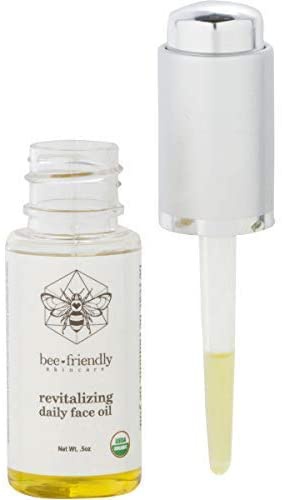
Revitalizing Daily Face Oil
Highlights
Key Ingredients
Skim through
| Ingredient name | what-it-does | irr., com. | ID-Rating |
|---|---|---|---|
| Organic Grape Seed Oil | antioxidant, emollient | goodie | |
| Organic Kukui Nut Oil | soothing, emollient | goodie | |
| Organic Raspberry Seed Oil | emollient | ||
| Organic Tamanu Oil | soothing, emollient | goodie | |
| Organic Raw Honey | soothing, moisturizer/humectant, antimicrobial/antibacterial | goodie | |
| Organic Sandalwood Essential Oil | |||
| Organic Turmeric Essential Oil | |||
| Organic Frankincense Essential Oil | |||
| Organic Helichrysum Essential Oil | perfuming |
Bee-Friendly Revitalizing Daily Face OilIngredients explained
A goodie plant oil coming from the polyphenol-rich seeds of the grape. It's a light emollient oil that makes your skin feel smooth and nice and also contains a bunch of good-for-the-skin stuff. It's a great source of antioxidant polyphenols, barrier repair fatty acid linoleic acid (about 55-77%, while oleic acid is about 12-27%) and antioxidant, skin-protectant vitamin E.
Having such a cool name and coming from Hawaii how could this oil be not good? Well, it is good. It's absorbed excellently by the skin and is used traditionally by the Hawaiians to soothe sunburn and other inflammations.
Research confirms this: it's shown to have anti-inflammatory, pain reducing, and wound healing properties. It's also a particularly rich source of moisturizing essential fatty acids linoleic and linolenic (about 42 and 32%) and it's not so rich in oleic acid - around 15% - that can be good even for acne prone skin.

An oil coming from cool places like Tahiti, Bora Bora, and the island of Polynesia. Similar to other more common plant oils, it's loaded with nourishing and moisturizing fatty acids (oleic acid: 40%, linoleic acid: 35%, palmitic acid: 15% and stearic acid: 11%).
Its unique thing is that it contains calophyllic acid that gives the oil extra healing and regenerating effects. A manufacturer even claims that tamanu oil can protect small capillary vessel and is recommended for redness and rosacea-prone skin.
We all know honey as the sweet, gooey stuff that is lovely to sweeten a good cup of tea and we have good news about putting honey all over our skin. It is just as lovely on the skin as it is in the tea.
The great review article about honey in the Journal of Cosmetic Dermatology writes that it is arguably the oldest skincare ingredient and evidence from around 4500 BC mentions honey in some eye cream recipes. Chemically speaking, it is a bee-derived, supersaturated sugar solution. About 95% of honey dry weight is sugar and the other 5% consists of a great number of other minor components including proteins, amino acids, vitamins, enzymes, and minerals.




You may also want to take a look at...
| what‑it‑does | antioxidant | emollient |
| what‑it‑does | soothing | emollient |
| what‑it‑does | emollient |
| what‑it‑does | soothing | emollient |
| what‑it‑does | soothing | moisturizer/humectant | antimicrobial/antibacterial |
| what‑it‑does | perfuming |





